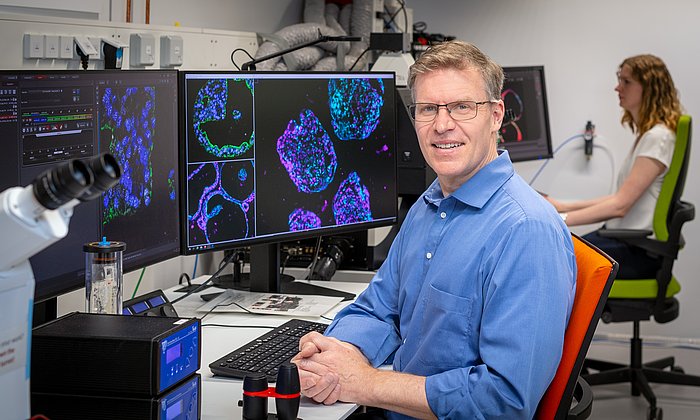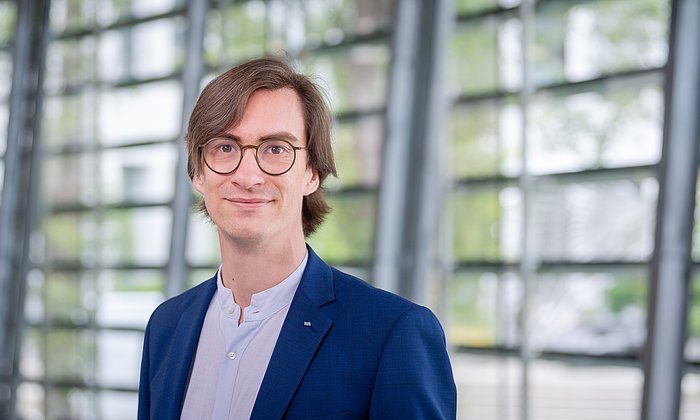NewIn: Carina Baer de Oliveira Mann
In search of molecular switches in the immune system
The human immune system is truly phenomenal: When pathogens enter the body, it triggers a chain of alarm signals within and between cells. Forming an important link in this chain are enzymes known as nucleotidyltransferases (NTases), which function like a switch: They recognize the foreign genetic material of viruses or bacteria within a cell and bind to it – changing their own structure. The switch is now activated.
One of these active NTases can then produce tiny molecules known as nucleotide messengers that trigger a chain reaction. These messengers can also alert nearby cells to activate their immune defenses.
A better understanding of molecular switches
If these NTases, or molecular switches, do not function as intended, then the sequence of fine-tuned signalling responses is disrupted and tumors may form. If they transmit too many signals, this may cause the immune system to overreact as in the case of autoimmune diseases.
“To develop new approaches to immunotherapies, it is therefore important to understand the mechanisms that control these molecular switches,” says Carina Baer de Oliveira Mann. As the Professor for Biomolecular Cryo Electron Microscopy, she is conducting research at the TUM School of Natural Sciences.
Growing up in the Portuguese coastal city of Cascais, west of Lisbon, Carina Baer de Oliveira Mann dreamed of becoming an architect. At 19 she moved to Munich to study biochemistry at TUM. Even in those days, she already saw creativity and freedom as important aspects of her future career. “In academic research I can decide for myself what to work on and how to approach it.”
Carina Baer de Oliveira Mann wrote her doctoral thesis at the Ludwig-Maximilians-Universität München. She was part of the research groups that studied the enzyme cGAS as the first NTase in 2013, completing a decades-long search.
Since this breakthrough, which was honored with the prestigious Lasker Award in 2024, researchers around the world have been striving to decode the mechanisms of cGAS. But not Carina Baer de Oliveira Mann: She is convinced that other NTases are present in the human immune system and is trying to identify them. “The usual approaches for detecting enzymes do not work. We and other research groups have tried them. So it’s going to take some creativity.”
The right method for every problem
To activate previously undiscovered molecular switches and make them visible, Professor Baer de Oliveira Mann and her team are therefore deploying a wide range of technologies, in particular cryogenic electron microscopy. “We start with a biological question and then adopt the methods that are best suited to answer it,” she says. Thanks to funding from the European Research Council, the team recently added a mass spectrometer to its toolbox. The team wants to use it to detect second messenger molecules produced by NTases.
If this leads to another step forward in the search for molecular switches in the immune system, Carina Baer de Oliveira Mann’s creativity and persistence will have paid off: “In many of our experiments the whole team waits in suspense for the outcome. When we succeed in shedding light on a new area and discover something previously unknown to others– that’s the biggest thrill for me.”
Carina Baer de Oliveira Mann holds the Professorship of Biomolecular Cryo Electron Microscopy at TUM. After completing a degree in biochemistry, she began a doctorate at the Gene Center of the Ludwig-Maximilians-Universität München (LMU). As a postdoc at Harvard University and later at LMU, she worked on regulatory mechanisms of nucleotidyltransferase cGAS and co-discovered cGAS proteins in bacteria that activate the immune response against phages. Before her appointment, she was an Emmy Noether group leader at the Institute of Virology at TUM.
Technical University of Munich
Corporate Communications Center
- Undine Ziller
- undine.ziller@tum.de
- presse@tum.de
- Teamwebsite
Contacts to this article:
Contact information:
Prof. Dr. Carina Baer de Oliveira Mann
Technical University of Munich (TUM)
Professorship of Biomolecular Cryo-Electron Microscopy
Tel.: +49 89 289 51690
carina.mann@tum.de




